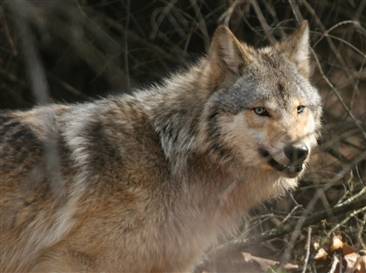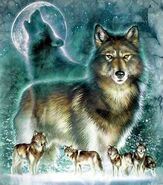The gray wolf (Canis lupus) is a species of canidnative to the wilderness and remote areas of North America, Eurasia, and North Africa. It is the largest member of its family, with males averaging 95–100 lbs, and females 80–85 lbs.[2] It is similar in general appearance and proportions to a German shepherd,[3] or sled dog, but has a larger head, narrower chest, longer legs, straighter tail and bigger paws.[4] Its winter fur is long and bushy, and is usually mottled gray in color, though it can range from nearly pure white, red, or brown to black.

The species originated during the middle Pleistoceneperiod, probably in the Indian subcontinent.Within the genus Canis, the gray wolf represents a morespecialised and progressive form than its smaller cousins (the coyote and golden jackal), as demonstrated by its morphological adaptations to hunting large prey, its more gregarious nature and its highly advanced expressive behavior.[7] It is a social animal, travelling in nuclear families consisting of a mated pair, accompanied by the pair's adult offspring.The gray wolf is typically an apex predator throughout its range, with only humans and tigers posing a serious threat to it. It feeds primarily on large ungulates, though it will also eat smaller animals, livestock, carrion, and garbage.It is present in Eastern and Central Europe and Central Asia. It still covers the greatest range among all gray wolf subspecies. The size of their territories depends on the abundance of food and water. They are very adaptable to different environments.The female will give birth to 4-7 pups after 61-63 days of gestation. To maintain the strength of the pack, only the dominant pair mate. However, all members of the pack are involved in raising the young.The gray wolf is one of the world's most well researched animals, with probably more books written about it than any other wildlife species. It has a long history of association with humans, having been despised and persecuted in most agricaul communities due to its attacks on livestock, while conversely being respected by someNative American tribes.It is the sole ancestor of the dog, which was first domesticated in the Middle East.Mortality factors affecting wolves include persecution by humans, killing by other wolves, diseases, parasites, starvation, and injuries by prey. The average lifespan in the wild is between 7 and 10 years



